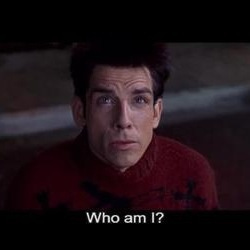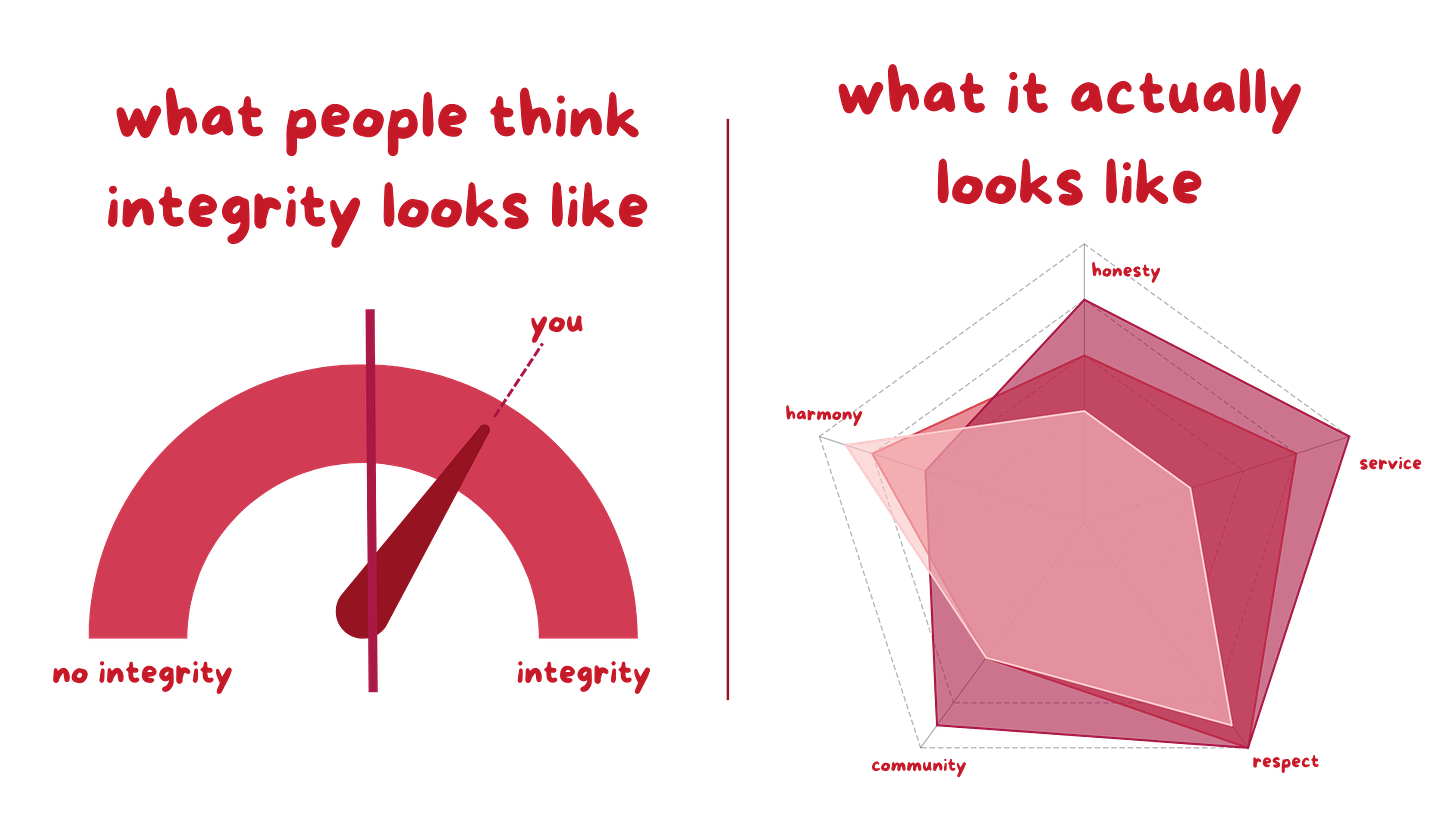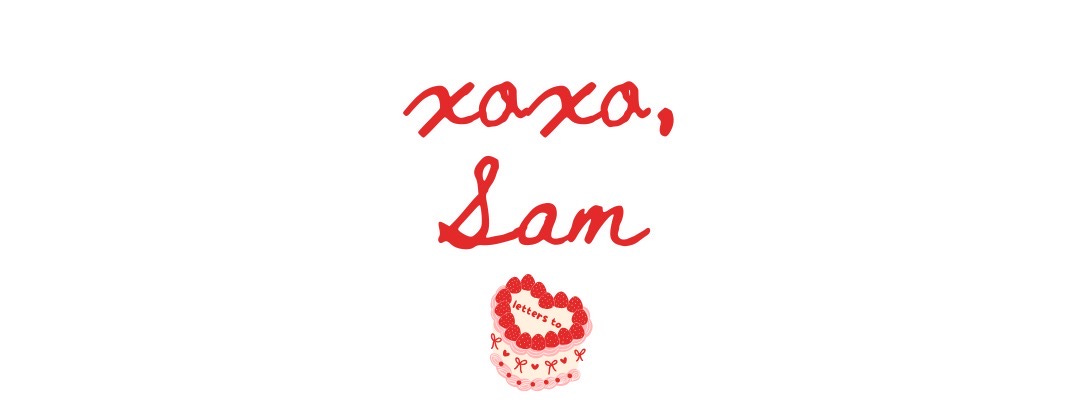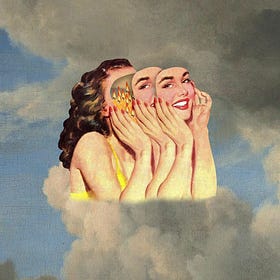To be in our integrity, we first need to not only know ourselves, but determine what we want our lives to look like, who we want to be, and how we want to show up.
I have been sitting with the idea of integrity for some time. Years, even, but more so in the last couple of months.
But, integrity is like porn – hard to define, but you definitely know it when you see it.
Because of how hard it is to define, though, the nuances and middle space of integrity are puzzling. I, like probably most people, know when something is absolutely in integrity and when something definitely isn’t.
Unfortunately, and also thankfully, most of life and life’s situations happen in the middle parts.
One of my best friends and I (you can view their podcast and hear all their wisdom here) talk about authenticity a lot. What is authenticity, what is integrity, what is ethical, what is moral? What do we owe people, and what do we owe ourselves, and how do we navigate when those things are all different in the same situation? (We are both psychology majors and professional yappers, again, see their podcast here.)
So, because of how heavy this has been on my mind – or maybe I shouldn’t say heavy, maybe I should just say present – I wanted to do some philosophical spelunking (sorry, that’s arguably one of my cringier lines, but I’m keeping it) into integrity and authenticity. So, strap on your goggles and harness, and let’s dive in!
Why don’t we begin with some general definitions?
Authenticity = being honest and genuine.
Integrity = aligning with your values and morals.
I think that all integrity is authentic, but not all authenticity is in integrity (although most of it it probably is). And, some level of authenticity is required for integrity.
authenticity: knowing the self and being known
Authenticity, in my own words, is when your outside matches your inside. Every statement is rooted in a primary value of honesty. To be authentic, one must know themself incredibly deeply and intimately. To know ourselves, we have to explore our darkness, our wounds, our desires, our boundaries, and our values. Being authentic is hard. Speaking truthfully is challenging.
I don’t do this very much now, thankfully, but in my early twenties, I was a compulsive liar. Not in the way you would think, or even in a way that is very interesting or salacious.
It might go something like this:
- “Are you okay?”Yes! (I’m so not.)
- “Do you mind if I ask this person on a date, even though you expressed interest in her?”No,Idon’tMindAtAll,ActuallyIWantYouTo,AndIActuallyHateThemNow! (I’m devastated.)
- No,I’mNotBusyToday,ICanHelpYou!!! (There’s a pile of homework that’s due by midnight next to me.)
- I’llBeOutOfTown!! (No, and now I’ll need to hide in my dorm room all weekend, just because I compulsively told a lie because I can’t say no.)
- IKnowHowToChangeOilInMyCar!! (No, I didn’t, and for some reason, I told this to my now husband in our first week of being friends, and like six months in, I had to awkwardly come clean that I lied – for NO reason.)
And that’s how I spoke them, too, like OneAnxiousWord!! It was a blurting, a word vomit, like being possessed. I never had the thought of, “I’m going to lie now,” but instead, it was like I was an observer, hearing these lies come out of my mouth.
A major reason I did this, besides deep-rooted childhood trauma that I can just save to talk to my therapist about, was because I had no strong sense of self. It was a desperate, knee-jerk reaction to try and find safety, even though I wasn’t in danger.
While I have a much stronger sense of self now in my late twenties, I think this is growing increasingly common in the younger generation. So many amazing YouTubers and Substackers have been talking about the rise of eras and aesthetics and cores on TikTok. A clean girl, a strawberry girl, a deer girl, an owl girl, a girl’s girl (side note, I feel like the least girl’s girl people I know adamantly insist on being a girl’s girl), soft feminine era, dark feminine era, sad girl core, girl dinner, girl math, I’m just a girl, brat summer, sad autumn, party girls, bookish girls, lit girls, thought daughters, Carrie Bradshaw (?.. this has been a popular one on Substack)… There’s probably so many more that I don’t even know about now that I’m barely on TikTok anymore.
“Every day, it feels like social media pushes a new aesthetic toward me, some ultra-specific, highly curated lifestyle… Tomato girl, pilates princess, now the thought daughter, it’s like casual enjoyment has disappeared, you must completely adapt your identity around your newest interest, often something you discover through social media.”
— oh so you're a thought daughter now? should i call joan didion? by Sarah Cucchiara
“You’re not a girlboss, a clean girl, or such a Pisces, you’re you, and there’s no one else quite like you. Those kinds of labels can be fun, I guess, but ultimately are limiting. It’s best to take an expansive view of the self. You don’t have to type yourself, or fit in with a specific group, box, or trend. In other words: it’s good to be different. Social media can really flatten us out.”
identity is complex, and knowing who we are will be, and always has been, a challenge
Not a bad challenge, because it’s what the human experience is inherently for. We are meant to explore who we are, what we believe in, what we feel, and what we value in this journey of being a beautiful and messy human being. And once we think we have it figured out, it’s probably already shifted. Identity is as complex as the sand, made up of so many grains, and ever shifting.
In Existentialism is a Humanism, Jean-Paul Sartre wrote, "Woman is nothing else but what she makes of herself." (He definitely didn’t use the feminine, as almost all the philosophers of that time and before spoke in terms of humanity as “man” and “him,” but I like to change it for myself, because this is my Substack and I can gender bend if I want to.)
“For the longest time, I thought I needed to find myself. I always thought that I just had to peel back enough layers and somewhere deep inside I’d uncover this perfectly polished version of me hidden underneath. But here’s the thing no one tells you: it’s not about finding some hidden treasure, it’s simply about authentically creating her. Piece by piece, choice by choice, day by day.”
— I thought I needed to find myself, turns out I need to build her instead, Robin Collins
"Being true to myself means being true to my own originality, and that is something only I can articulate and discover."
— Charles Taylor, The Ethics of Authenticity
We build up what is true for ourselves in every moment we are awake and alert. As one of my other dear friends said, “What we don’t change, we choose.”
It’s important to mention that authenticity isn’t always all “positive.” Being authentic, even just by ourselves, is painful. Authenticity means knowing our rage, our irritation, our selfishness, our greed, our jealousy, our automatic and unkind thoughts, our judgments, our grief, our sorrow, our misery, our fear, our insecurities, and our not-so-shiny, pretty, polished selves. In Psychological Reflections, Carl Jung wrote, “Wholeness is not achieved by cutting off a portion of one’s being, but by integration of the contraries.” Jung is also well known for his musings on his writings on our “shadow” selves. An alchemical phrase, as above so below, was popularized by Jung… and then later, by spiritual capitalists on TikTok.
Even though the complex work of Jung and all of the fascinating work of Jungian psychologists has been whittled down into bite-sized, albeit varying degrees of inaccurate and incomplete, chunks of simplicity by social media (where nuance goes to die), this is very much still a powerful statement to remember. Jung also argued that until one makes the unconscious conscious, it will direct their life and one will call it fate.
“You are the sum of every wonderful thing and every terrible thing and every boring thing that has ever happened to you. Which is to say: you are a patchwork of contrasting emotions, stuck together, mosaic-like. You are not the product of a capitalist system that expects happiness, all the time.”
integrity, the sum of all your parts in alignment
If authenticity is about honesty and being well acquainted with the self, and letting others be acquainted with yourself, I think integrity is how that knowledge fits in with the way we interact with others, make decisions, and move through the world around us.
Authenticity is the constant evolution of knowing our true selves and being known as that true self.
Integrity is our ethical responsibility to live in accordance with our values and morals.
To be in our integrity, though, we first need to not only know ourselves, but determine what we want our lives to look like, who we want to be, and how we want to show up.
In my opinion, starting with identifying your values is a perfect place to start when thinking about integrity. You can use this worksheet from Simple Practice for free. Their website defines values as, “The fundamental beliefs and guiding principles that shape an individual's behavior, decisions, and interactions with others. These beliefs and values are considered part of a person's character or identity. They represent what a person finds most important.”
Also, Brene Brown’s worksheet about values is quite good and helpful, although I feel a bit icky towards her as of late. Here it is though, because even if she is questionable, this resource is quite good.
For reference, my main values include: community (which to me includes belonging, inclusion, safety, and service), curiosity, ethics, growth, love/kindness and respect (for others, myself, and my environment).
For my husband, his values include: commitment, security, harmony, health, order, and family.
Just as our authentic selves differ, so would our guidelines of integrity. And just because I wouldn’t necessarily say that harmony is a core value, it’s not not a core value either. It’s easy to see the list of values and think, “Well, all of these are good!” It’s more about what handful of words on this list either speak to the core of your soul or inspire the person you want to be/someone you feel proud of.
An example in action might be that he might be more likely to prioritize harmony and keeping the peace, whereas I might prioritize setting a boundary if I feel like myself, or someone I care about, is being unfairly disrespected. Which isn’t to say that he would never choose to set a boundary, or that I would never opt for harmony instead of ruffling feathers, but this shows a general example of how having slightly different leading values can lead to different approaches – neither of which are good or bad or right or wrong.
In fact, this is an exercise which often helps me have empathy or understanding when I feel judgment of criticism of someone else’s actions. When I feel like someone else is just doing the wrong thing, it helps to speculate on what their values might be and how their actions then make a lot more sense through that lens. And often, the inspiring value is something I can respect, even if I don’t necessarily align with their decisions.
in my eyes, this is what authenticity would look like:
integrity, while I think includes authenticity, would look a little bit like this:
This is not even considering that we will place different weight on different values in different situations.
For example, when I’m at work, how I show up with integrity is different than how I would show up with integrity with my best friend or at a party.
integrity in different situations might look more like this:
At work, professionalism and productivity become a bit more of a priority than authenticity and love. With my best friend/husband/father, service is a huge priority, whereas for an acquaintance, it is a little smaller. I’m going to center my self-care and solitude when I’m going through hard times, but if I have a friend (or even co-worker or acquaintance) going through grief or hardship, I will place a very large amount on service and support for them and have much fewer boundaries in my relationship with them.
This is what can be soo challenging about integrity.
It’s not the same in every situation, with every person, in every environment, and it’s not even the same with the same person all the time!
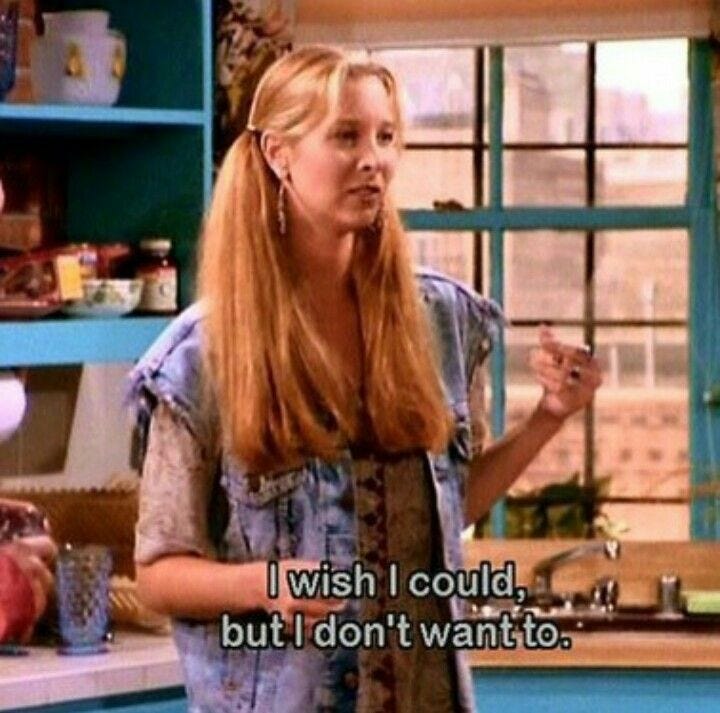
When my mother died, I took intermittent FMLA at work, so while I was being productive during my working hours, it was less about how much I could accomplish and help my team, but more about how I could most efficiently get the basics done and what I could ask for help carrying. Now, however, I often reach out to see how I can carry more for others on my team and how I can help with more projects.
When I’m around my best friends, I place a lot of value in being silly, affectionate, vulnerable, open, and joyful. However, if I’m around someone that I may like, but don’t have a close relationship with, I will probably place more value in being polite, respectful, and kind. Neither one of those is more true to myself than the other. I’m not being fake if I hold parts of myself closer or turn the dial down on being silly
Integrity is not a definitive location, it’s not something you either are or aren’t.
I know someone who can be very hard on themselves when they feel like they aren’t being “authentic.” However, I don’t believe that this is something so simple or black and white as this — at least not always.
Using a lighthearted example, I love to hug people. I like to hug when I meet someone, when I am greeting someone I know, when I’m saying goodbye, when they say something sad, when they say something exciting, etc etc. But just because I’m a hugger, doesn’t mean that I walk up to the CEO at my work and give him a big hug. I don’t decline the barista’s high five, walk around the counter, and give him a jovial embrace. Even though it’s authentic for me to hug, it’s not inauthentic to not hug when it’s not quite appropriate.
I think some of us have seen the relatively new-ish graphic of what we used to refer to as the autism spectrum. “People tend to believe is that the spectrum is linear and every autistic person is a dot on the line, either less autistic or more autistic, or ‘high functioning’ or ‘low functioning’,” Josephine Moon wrote in the article, What is the Autism Spectrum? “In reality, the spectrum is like a pie chart… Every Autistic person has
a ‘spiky’ profile where we’re really good at some things and struggle a
lot with others. Everyone’s pie chart will look different.”
I think that this is what integrity looks like.
"To will oneself moral and to will oneself free are one and the same decision."
— Simone de Beauvoir, The Ethics of Ambiguity
letters to taking off the mask
you’re loveable not in spite of your neurodivergence, but because of it






